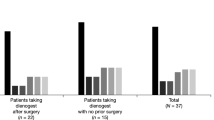Abstract
This Phase 2 study evaluated the safety and efficacy of elagolix for treating endometriosis-associated pain. A total of 155 women with laparoscopically confirmed endometriosis were randomized to placebo, elagolix 150 mg, or elagolix 250 mg once daily for 12 weeks. Placebo patients were rerandomized to elagolix and elagolix patients continued their dosing assignment for 12 additional weeks; the primary efficacy measure was changed from baseline in the monthly mean numerical rating scale for pain at week 12. Monthly mean (standard error of the mean) reductions were greater with elagolix versus placebo (−1.19 ± 0.18, −1.25 ± 0.18, and −0.88 ± 0.18 for elagolix 150 mg, 250 mg, and placebo, respectively); differences were not statistically significant. Monthly mean dysmenorrhea and nonmenstrual pelvic pain scores were reduced with elagolix, with significant differences for dysmenorrhea at weeks 8 and 12 versus placebo (P <.05). Minimal bone mineral density changes were observed with elagolix treatment. In women with endometriosis-associated pain, elagolix demonstrated an acceptable efficacy and safety profile in this Phase 2 study.
Similar content being viewed by others
References
Carr BR. Williams gynecology. In: Schorge JO, Schaffer JI, Halvorson LM, Hoffman B, Bradshaw KD, Cunningham FG, eds. Endometriosis. Chapter 10. New York, NY: McGraw-Hill; 2008.
Chapron C, Fauconnier A, Dubuisson JB, Barakat H, Vieira M, Breart G. Deep infiltrating endometriosis: relation between severity of dysmenorrhoea and extent of disease. Hum Reprod. 2003;18(4):760–766.
Vercellini P, Fedele L, Aimi G, Pietropaolo G, Consonni D, Crosignani PG. Association between endometriosis stage, lesion type, patient characteristics and severity of pelvic pain symptoms: a multivariate analysis of over 1000 patients. Hum Reprod. 2007;22(1):266–271.
Vercellini P, Trespidi L, De Giorgi O, Cortesi I, Parazzini F, Crosignani PG. Endometriosis and pelvic pain: relation to disease stage and localization. Fertil Steril. 1996;65(2):299–304.
ACOG Committee on Practice Bulletins—Gynecology. ACOG Practice bulletin No. 51. chronic pelvic pain. Obstet Gynecol. 2004;103(3):589–605.
Practice Committee of American Society for Reproductive Medicine. Treatment of pelvic pain associated with endometriosis. Fertil Steril. 2008;90(suppl 5):S260-S269.
Evans S, Moalem-Taylor G, Tracey DJ. Pain and endometriosis. Pain. 2007;132 (suppl 1):S22-S25.
Greene R, Stratton P, Cleary SD, Ballweg ML, Sinaii N. Diagnostic experience among 4,334 women reporting surgically diagnosed endometriosis. Fertil Steril. 2009;91(1):32–39.
Kennedy S, Bergqvist A, Chapron C, et al. ESHRE guideline for the diagnosis and treatment of endometriosis. Hum Reprod. 2005;20(10):2698–2704.
Bulun SE, Cheng YH, Pavone ME, et al. Estrogen receptor-beta, estrogen receptor-alpha, and progesterone resistance in endometriosis. Semin Reprod Med. 2010;28(1):36–43.
Crosignani PG, Luciano A, Ray A, Bergqvist A. Subcutaneous depot medroxyprogesterone acetate versus leuprolide acetate in the treatment of endometriosis-associated pain. Hum Reprod. 2006;21(1):248–256.
Schlaff WD, Carson SA, Luciano A, Ross D, Bergqvist A. Subcutaneous injection of depot medroxyprogesterone acetate compared with leuprolide acetate in the treatment of endometriosis-associated pain. Fertil Steril. 2006;85(2):314–325.
Vercellini P, Fedele L, Pietropaolo G, Frontino G, Somigliana E, Crosignani PG. Progestogens for endometriosis: forward to the past. Hum Reprod Update. 2003;9(4):387–396.
Batzer FR. GnRH analogs: options for endometriosis-associated pain treatment. J Minim Invasive Gynecol. 2006;13(6):539–545.
Olive DL. Gonadotropin-releasing hormone agonists for endometriosis. N Engl J Med. 2008;359(11):1136–1142.
Surrey ES. Gonadotropin-releasing hormone agonist and add-back therapy: what do the data show? Curr Opin Obstet Gynecol. 2010;22(4):283–288.
Fuldeore MJ, Marx SE, Chwalisz K, Smeeding JE, Brook RA. Add-back therapy use and its impact on LA persistence in patients with endometriosis. Curr Med Res Opin. 2010;26(3):729–736.
Guo SW. Recurrence of endometriosis and its control. Hum Reprod Update. 2009;15(4):441–461.
Tandoi I, Somigliana E, Riparini J, Ronzoni S, Vigano P, Candiani M. High rate of endometriosis recurrence in young women. J Pediatr Adolesc Gynecol. 2011;24(6):376–379.
International conference on harmonisation of technical requirements for registation of pharmaceuticals for human use. Good Clinical Practice. http://ichgcp.net/. Accessed June 28, 2011.
Biberoglu KO, Behrman SJ. Dosage aspects of danazol therapy in endometriosis: short-term and long-term effectiveness. Am J Obstet Gynecol. 1981;139(6):645–654.
Farrar JT, Young JP Jr, LaMoreaux L, Werth JL, Poole RM. Clinical importance of changes in chronic pain intensity measured on an 11-point numerical pain rating scale. Pain. 2001;94(2):149–158.
Jones G, Jenkinson C, Kennedy S. Development of the short form endometriosis health profile questionnaire: the EHP-5. Qual Life Res. 2004;13(3):695–704.
Struthers RS, Xie Q, Sullivan SK, et al. Pharmacological characterization of a novel nonpeptide antagonist of the human gonadotropin-releasing hormone receptor, NBI-42902. Endocrinology. 2007;148(2):857–867.
Matsuo H. Prediction of the change in bone mineral density induced by gonadotropin-releasing hormone agonist treatment for endometriosis. Fertil Steril. 2004;81(1):149–153.
Uemura T, Mohri J, Osada H, Suzuki N, Katagiri N, Minaguchi H. Effect of gonadotropin-releasing hormone agonist on the bone mineral density of patients with endometriosis. Fertil Steril. 1994;62(2):246–250.
Carr B, Chwalisz K, Jimenez R, Burke J, Jiang P, O’Brien C. A novel oral GnRH antagonist, elagolix, is effective for reducing endometriosis-associated pelvic pain: results of a 24-week randomized study. Fertil Steril. 2011;96(3):S45.
Author information
Authors and Affiliations
Corresponding author
Rights and permissions
About this article
Cite this article
Diamond, M.P., Carr, B., Dmowski, W.P. et al. Elagolix Treatment for Endometriosis-Associated Pain: Results from a Phase 2, Randomized, Double-Blind, Placebo-Controlled Study. Reprod. Sci. 21, 363–371 (2014). https://doi.org/10.1177/1933719113497292
Published:
Issue Date:
DOI: https://doi.org/10.1177/1933719113497292




